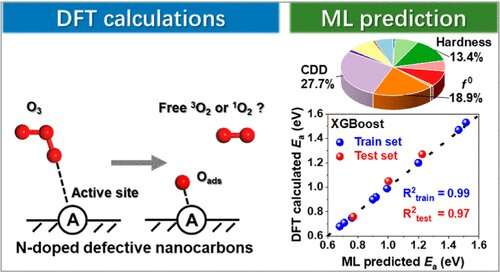Reaction mechanism of O3 activation and singlet oxygen generation on N-doped defective nanocarbons

A research team led by Prof. Cao Hongbin from the Institute of Process Engineering (IPE) of the Chinese Academy of Sciences has revealed the catalytic reaction mechanism of O3 activation and singlet oxygen (1O2) generation on N-doped defective nanocarbons.
This work was published in Environmental Science & Technology on May 26.
Catalytic ozonation is promising for water purification due to its excellent performance in pollutants abatement, which generally relies on the efficient conversion of O3 into reactive oxygen species. However, the reaction mechanism of catalytic ozonation remains unclear.
In this study, the researchers chose eight representative configurations of N-doped defective nanocarbons (N-DNCs) and 10 active sites, and systematically mapped out the O3 decomposition processes on these active sites by density functional theory (DFT) calculations.
They found that O3 could decompose into an adsorbed atomic oxygen species (Oads) and an 3O2 on the active sites. The Oads may not only act as an initiator for generating reactive oxygen species, but also directly attack the organics on partial sites.
On the N site and C site of the N4V2 system (quadri-pyridinic N with two vacancies) and the pyridinic N site at edge, O3 could be activated into 1O2 in addition to 3O2. The N4V2 system is predicted to have the best activity among the N-DNCs studied, said Dr. Yu Guangfei from IPE.
Furthermore, based on the DFT results, the machine learning models were utilized to correlate the O3 activation activity with the local and global properties of the catalyst surfaces. Among several models, XGBoost performed the best, with the condensed dual descriptor being the most important feature.
"This contribution not only provides insights into the molecular mechanism of catalytic ozonation process on N-DNCs, but also demonstrates the power of combining the DFT calculation with machine learning for predicting catalytic performance of novel materials," said Prof. Xie Yongbing from IPE. "This approach can be extended to search for and design efficient catalysts for environmental and other applications."
More information: Guangfei Yu et al, Insights into the Mechanism of Ozone Activation and Singlet Oxygen Generation on N-Doped Defective Nanocarbons: A DFT and Machine Learning Study, Environmental Science & Technology (2022).
Journal information: Environmental Science & Technology
Provided by Chinese Academy of Sciences





















